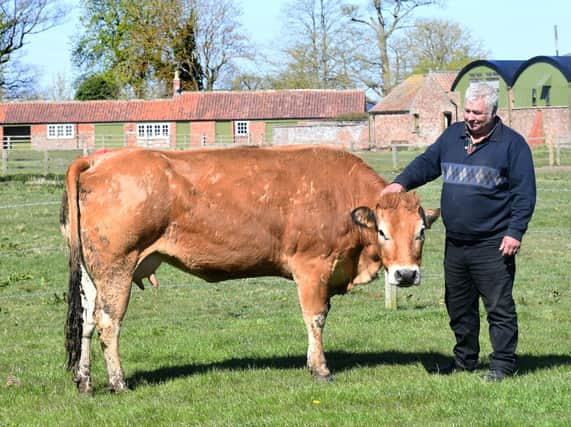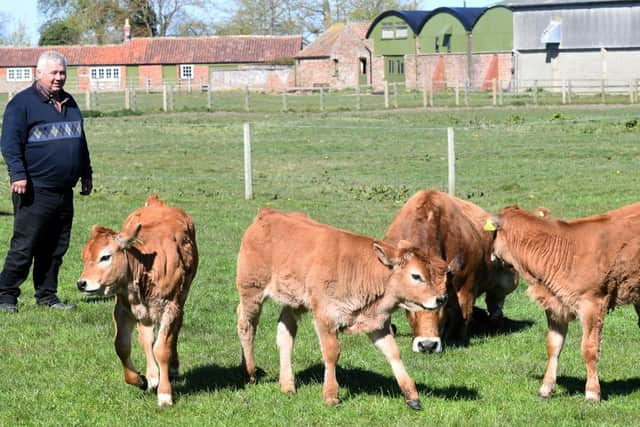Farm of the Week: A little bit of France in Old Malton with a Parthenais herd producing low-fat beef


Andrew has pedigree and commercial crossbred Parthenais and has increased to 50 breeding cows since buying his first pedigree bull 15 years ago.
His cattle are based on 60 acres of low-lying land that he rents at Espersykes Farm, Old Malton and a further 80 acres of Forestry Commission land near Dalby.
Advertisement
Hide AdAdvertisement
Hide AdAndrew said the breed, which he switched to from Longhorns, ticks all the boxes in terms of beef quality and breeding stock.


“They are definitely starting to catch on. Bulls and heifers are in great demand. I can sell as many heifers as I breed. We are finding buyers swapping over from other breeds because of the Parthenais’ easy calving, maternal traits, fast growth rate and high beef content.”
Andrew said the Parthenais breed was once a triple-purpose animal, used for dairy, beef and draught work, but that around half a century ago there was a concentration on it being solely a beef animal.
“There is a massive premium on Parthenais beef in France because of its healthy meat. It has been proven to have less cholesterol than chicken, because of being low in fat content, and with its great marbling the taste of its beef is highly regarded worldwide.
Advertisement
Hide AdAdvertisement
Hide Ad“British suckler herd farmers have been impressed and that’s why there is a great demand for both pedigree Parthenais and Parthenais-cross females as commercial herd replacements.”
Espersykes Parthenais, Andrew’s pedigree herd, is where he feels his future lies with the breed. He said he intends to move his herd over to wholly pedigree in future.
“I’d like to get to a herd of 50 all-pedigree Parthenais breeding cows and I’ll achieve that when I produce enough pedigree heifers. They don’t cost any more to keep than the Parthenais-cross commercial cattle, and their pedigree progeny is worth more.
“Even if I sell the pedigrees to go into commercial herds they will still go on to command a better price than those that are crossbreds. They are big, muscly cattle that look good and grow very well off grass.”
Advertisement
Hide AdAdvertisement
Hide AdAndrew uses AI on all his pedigree cows and is keeping all of his pedigree heifers as he aims for his target figure. He has eight heifers to bull with AI later this year which should go some way to increasing the herd. He uses a homegrown bull, Charlie, on his commercial herd.
Andrew said the non-pedigree cows all date back to other breeds of bull he has used in the past.
“I’ve had Simmental, Limousin, Angus and Longhorn bulls, which means there are various crossbreds of Simmental-cross-Parthenais, Angus-cross-Longhorn although hardly any Limousin-cross as the Limmie bull turned infertile.
“Every commercial crossbred cow and heifer I have is now being put to Charlie, who is out of a bull called Hurricane Gonzo and one of my own cows. The commercial herd is now approaching three-quarter Parthenais.”
Advertisement
Hide AdAdvertisement
Hide AdAndrew currently has two main outlets for his stock going to beef.
“I sell crossbred stores at Selby livestock market and the best of them are bought by a good friend who buys them as stores to fatten. It is their high meat content that is attracting greater interest too.
“They are 77 per cent meat and of that percentage 41 per cent is at the high end of quality cuts. In France they sell at the equivalent of £5.25 per kilo and that means a beast can be worth around £3000-plus.”
Calving at Espersykes takes place in March and April. Andrew turns his stock out on to his rented land next to the River Derwent and during the summer they also graze 20 to 30 at a time up at Dalby.
Advertisement
Hide AdAdvertisement
Hide Ad“I’ve rented this land at Espersykes for 15 years and been based here for 10 years having previously rented land at Huttons Ambo when I had my Longhorn herd. I’ve had the land at Dalby since I had the Longhorns too. It’s on SSSI land and so I can only take the cattle up there in July on three parcels of good grassland, scrub and woodland.”
Andrew was the youngest of nine children to his parents Miah Edgar Allanson and Lucy who farmed at Fryup, Bransdale, Snilesworth and Rosedale. He went to school in Osmotherley, Rosedale and Pickering, after his parents had moved out of farming and were living in Thornton-le-Dale. He said it wasn’t his most successful time.
“I left school with no qualifications and I’ve still got none. All I ever wanted was my own place and to do my own thing and after working for Tony Stockdale at Allerston for a few years and then SB Bulmer livestock on Newton Road in Pickering looking after pigs for seven years I set up my own sow herd.”
Having built up his sow herd to 60 Landrace-cross-Welsh and other crosses on three units and selling to local butchers he came out of the pig world in 1991. He said the decision was an easy one to make.
Advertisement
Hide AdAdvertisement
Hide Ad“The pig job had gone bad. They weren’t making anything. I’ve always subsidised my farming by doing other jobs such as working for the Forestry Commission.
“I’ve planted trees, undertaken fencing and spraying work mainly in Dalby Forest, Cropton and on Wykeham Estate. I’ve also had winter work on a gritting and snow ploughing contract at Dalby for the last 15 years and currently keep some pigs on a bed and breakfast arrangement.”
Andrew said he would love to go over to the Nouvelle Aquitaine region where the Parthenais comes from and that if things had turned out differently he could have been living there.
“When I was selling my land at Seamer in 2001 I was going to move to France. You could buy farms cheaply, but by the time I sold prices had gone beyond what I could afford. I now have my own slice of France with these wonderful cattle.”